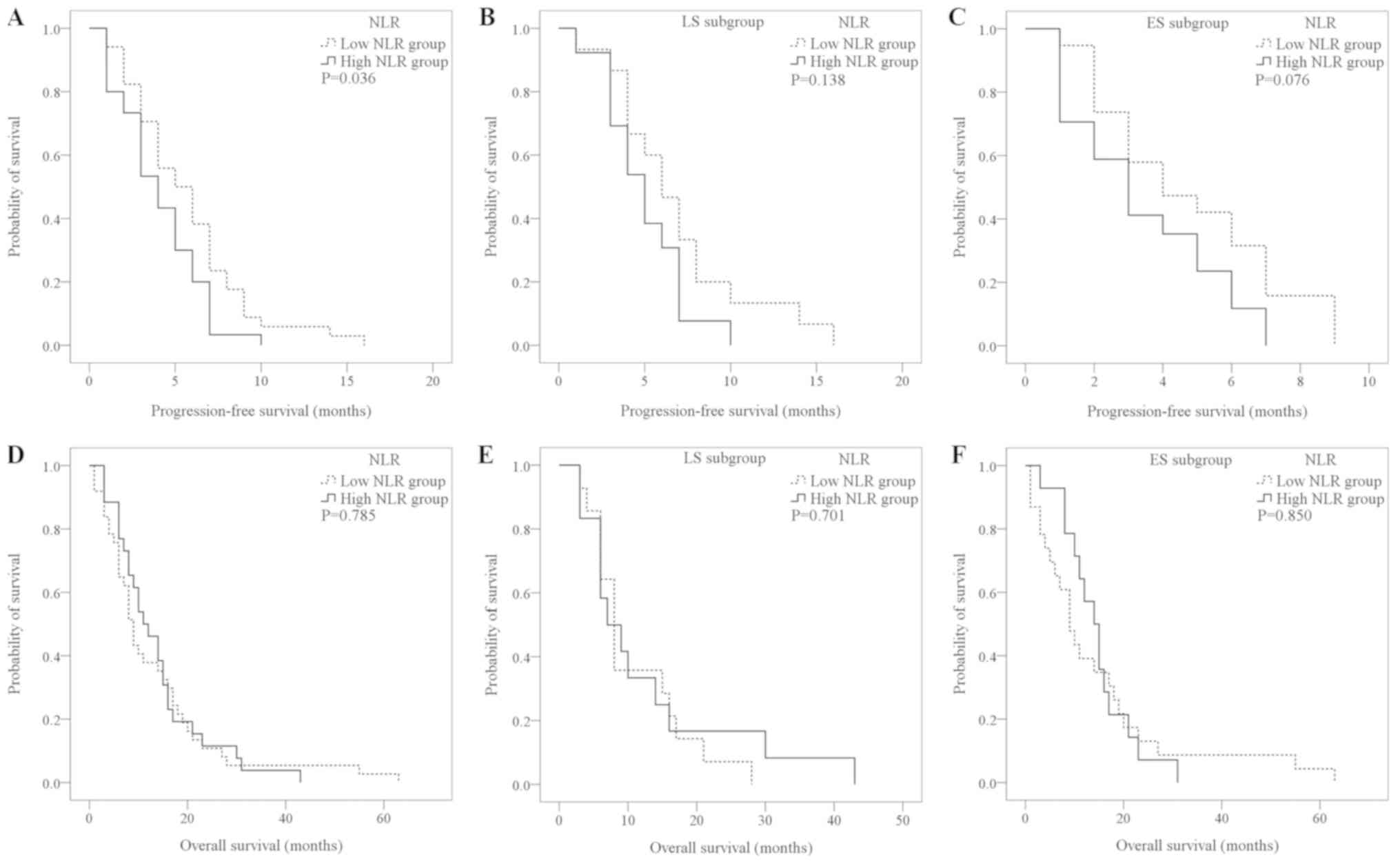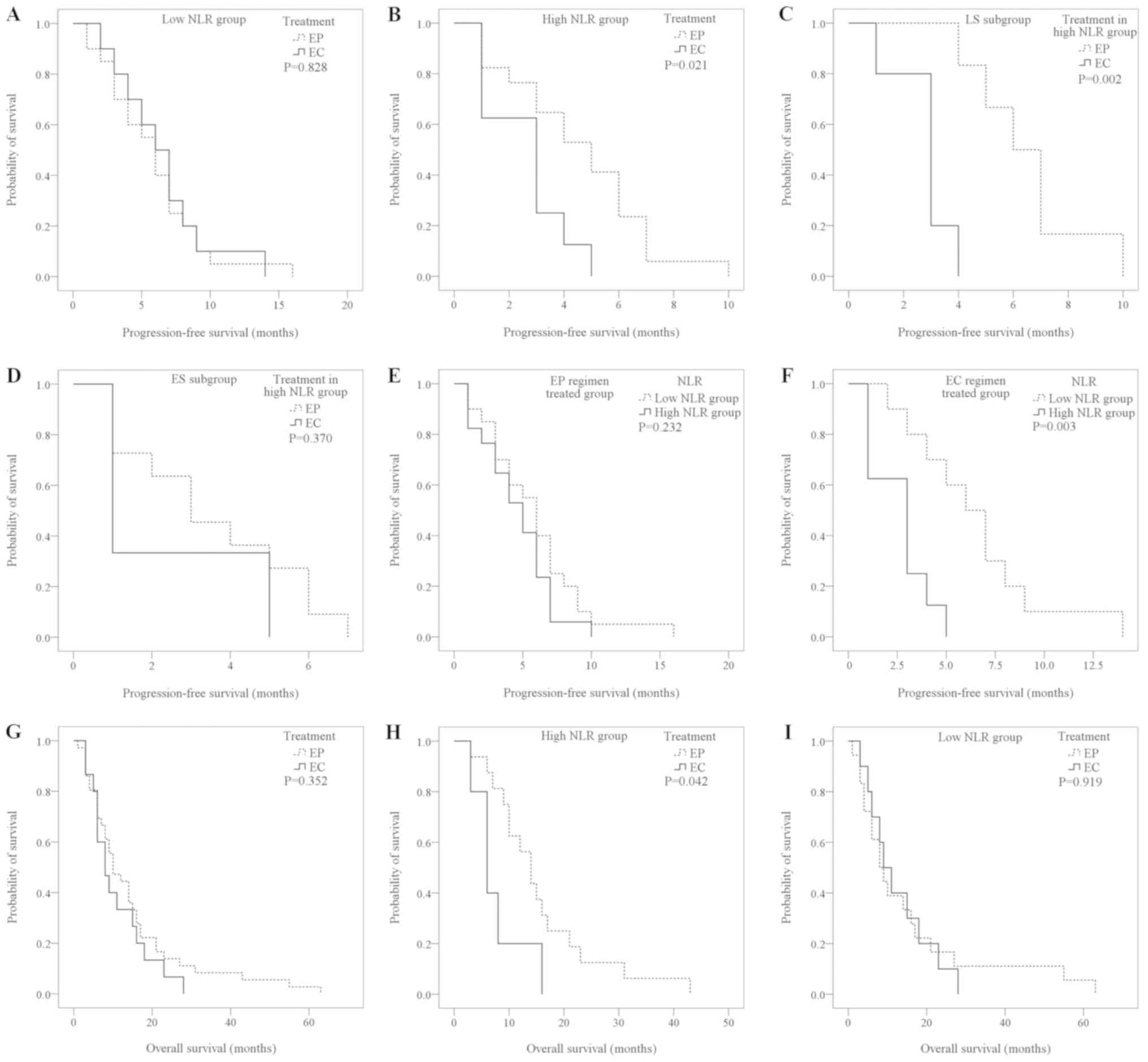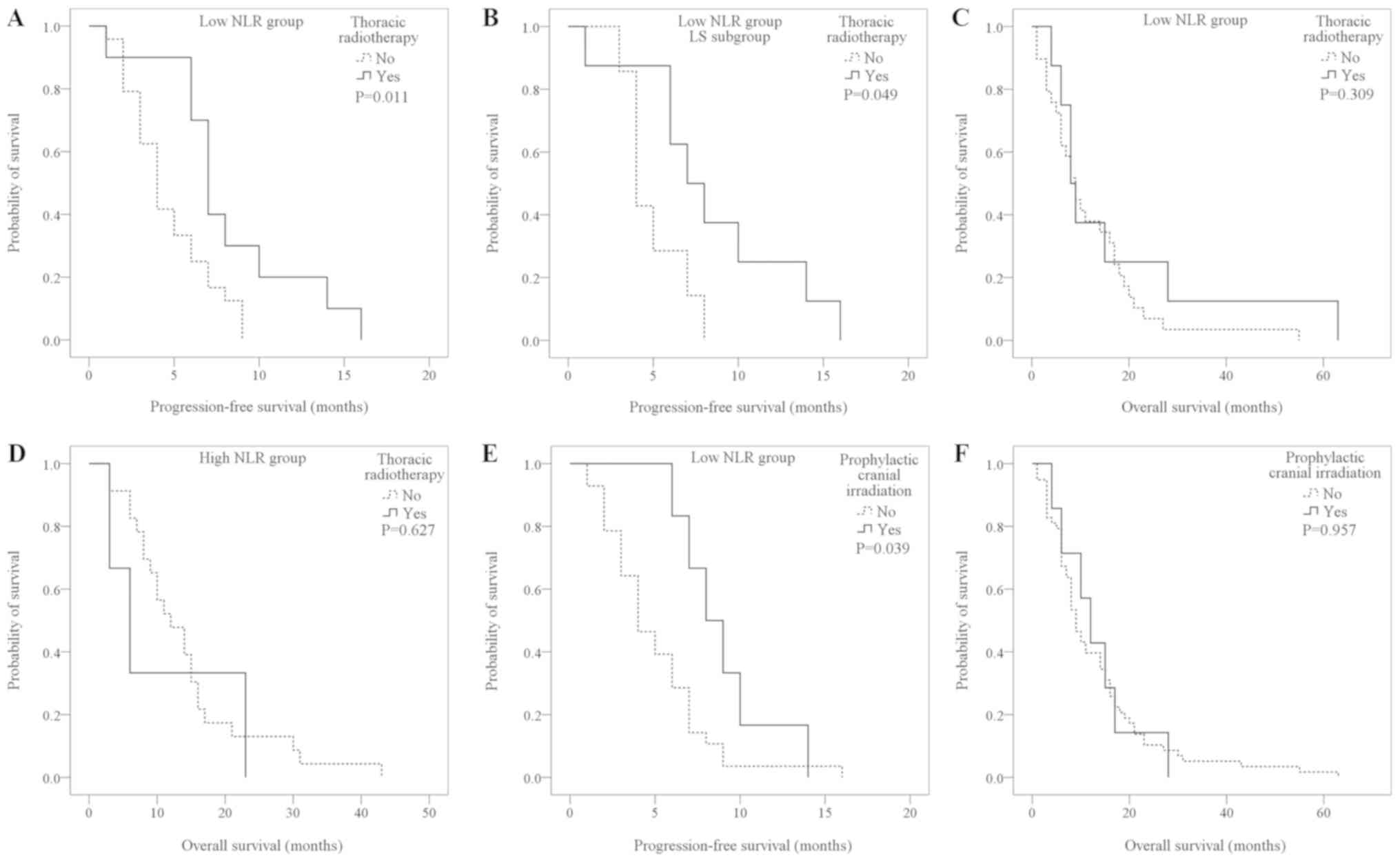|
1
|
Torre LA, Bray F, Siegel RL, Ferlay J,
Lortet-Tieulent J and Jemal A: Global cancer statistics, 2012. CA
Cancer J Clin. 65:87–108. 2015. View Article : Google Scholar : PubMed/NCBI
|
|
2
|
Klutker G, Sauer R and Fietkau R: Combined
treatment modality in small cell lung cancer: The impact of
radiotherapy on survival. Strahlenther Onkol. 184:61–66. 2008.
View Article : Google Scholar : PubMed/NCBI
|
|
3
|
Kurup A and Hanna NH: Treatment of small
cell lung cancer. Crit Rev Oncol Hematol. 52:117–126. 2004.
View Article : Google Scholar : PubMed/NCBI
|
|
4
|
Puglisi M, Dolly S, Faria A, Myerson JS,
Popat S and O'Brien ME: Treatment options for small cell lung
cancer-do we have more choices? Br J Cancer. 102:629–638. 2010.
View Article : Google Scholar : PubMed/NCBI
|
|
5
|
Gaspar LE, Mcnamara EJ, Gay EG, Putnam JB,
Crawford J, Herbst RS and Bonner JA: Small-cell lung cancer:
Prognostic factors and changing treatment over 15 years. Clin Lung
Cancer. 10:115–122. 2009.
|
|
6
|
Murray N and Turrisi AT III: A review of
first-line treatment for small-cell lung cancer. J Thorac Oncol.
1:270–278. 2006. View Article : Google Scholar : PubMed/NCBI
|
|
7
|
Rossi A, Di Maio M, Chiodini P, Rudd RM,
Okamoto H, Skarlos DV, Früh M, Qian W, Tamura T, Samantas E, et al:
Carboplatin- or cisplatin-based chemotherapy in first-line
treatment of small-cell lung cancer: The COCIS meta-analysis of
individual patient data. J Clin Oncol. 30:1692–1698. 2012.
View Article : Google Scholar : PubMed/NCBI
|
|
8
|
O'Dwyer PJ and Calvert AH: Platinum
analogs. Cancer: Principles and Practice of Oncology. DeVita VT,
Lawrence TS and Rosenbery SA: 10th. Lippincott Williams &
Wilkins; Philidelphia, PA: pp. 199–207. 2015
|
|
9
|
Go RS and Adjei AA: Review of the
comparative pharmacology and clinical activity of cisplatin and
carboplatin. J Clin Oncol. 17:409–422. 1999. View Article : Google Scholar : PubMed/NCBI
|
|
10
|
O'Callaghan DS, O'Donnell D, O'Connell F
and O'Byrne KJ: The role of inflammation in the pathogenesis of
non-small cell lung cancer. J Thorac Oncol. 5:2024–2036. 2010.
View Article : Google Scholar : PubMed/NCBI
|
|
11
|
Gondo T, Nakashima J, Ohno Y, Choichiro O,
Horiguchi Y, Namiki K, Yoshioka K, Ohori M, Hatano T and Tachibana
M: Prognostic value of neutrophil-to-lymphocyte ratio and
establishment of novel preoperative risk stratification model in
bladder cancer patients treated with radical cystectomy. Urology.
79:1085–1091. 2012. View Article : Google Scholar : PubMed/NCBI
|
|
12
|
Mano Y, Shirabe K, Yamashita Y, Harimoto
N, Tsujita E, Takeishi K, Aishima S, Ikegami T, Yoshizumi T,
Yamanaka T and Maehara Y: Preoperative neutrophil-to-lymphocyte
ratio is a predictor of survival after hepatectomy for
hepatocellular carcinoma: A retrospective analysis. Ann Surg.
258:301–305. 2013. View Article : Google Scholar : PubMed/NCBI
|
|
13
|
Zheng YB, Zhao W, Liu B, Lu LG, He X,
Huang JW, Li Y and Hu BS: The blood neutrophil-to-lymphocyte ratio
predicts survival in patients with advanced hepatocellular
carcinoma receiving Sorafenib. Asian Pac J Cancer Prev.
14:5527–5531. 2013. View Article : Google Scholar : PubMed/NCBI
|
|
14
|
Yao Y, Yuan D, Liu H, Gu X and Song Y:
Pretreatment neutrophil to lymphocyte ratio is associated with
response to therapy and prognosis of advanced non-small cell lung
cancer patients treated with first-line platinum-based
chemotherapy. Cancer Immunol Immunother. 62:471–479. 2013.
View Article : Google Scholar : PubMed/NCBI
|
|
15
|
Unal D, Eroglu C, Kurtul N, Oguz A and
Tasdemir A: Are neutrophil/lymphocyte and platelet/lymphocyte rates
in patients with non-small cell lung cancer associated with
treatment response and prognosis? Asian Pac J Cancer Prev.
14:5237–5242. 2013. View Article : Google Scholar : PubMed/NCBI
|
|
16
|
Kacan T, Babacan NA, Seker M, Yucel B,
Bahceci A, Eren AA, Eren MF and Kilickap S: Could the neutrophil to
lymphocyte ratio be a poor prognostic factor for non small cell
lung cancers? Asian Pac J Cancer Prev. 15:2089–2094. 2014.
View Article : Google Scholar : PubMed/NCBI
|
|
17
|
Eisenhauer EA Therasse P, Bogaerts J,
Schwartz LH, Sargent D, Ford R, Dancey J, Arbuck S, Gwyther S,
Mooney M, et al: New response evaluation criteria in solid tumours:
Revised RECIST guideline (version 1.1). Eur J Cancer. 45:228–247.
2009. View Article : Google Scholar : PubMed/NCBI
|
|
18
|
Micke P, Faldum A, Metz T, Beeh KM,
Bittinger F, Hengstler JG and Buhl R: Staging small cell lung
cancer: Veterans administration lung study group versus
international association for the study of lung cancer-what limits
limited disease? Lung Cancer. 37:271–276. 2002. View Article : Google Scholar : PubMed/NCBI
|
|
19
|
Naidoo J, Kehoe M, Sasiadek W, Hacking D
and Calvert P: Prophylactic cranial irradiation in small cell lung
cancer: A single institution experience. Ir J Med Sci. 183:129–132.
2014. View Article : Google Scholar : PubMed/NCBI
|
|
20
|
Byers LA and Rudin CM: Small cell lung
cancer: Where do we go from here? Cancer. 121:664–672. 2015.
View Article : Google Scholar : PubMed/NCBI
|
|
21
|
Ettinger DS and Aisner J: Changing face of
small-cell lung cancer: Real and artifact. J Clin Oncol.
24:4526–4527. 2006. View Article : Google Scholar : PubMed/NCBI
|
|
22
|
van Meerbeeck JP, Fennell DA and De
Ruysscher DK: Small-cell lung cancer. Lancet. 378:1741–1755. 2011.
View Article : Google Scholar : PubMed/NCBI
|
|
23
|
Evans W, Shepherd FA, Feld R, Osoba D,
Dang P and Deboer G: VP-16 and cisplatin as first-line therapy for
small-cell lung cancer. J Clin Oncol. 3:1471–1477. 1885. View Article : Google Scholar
|
|
24
|
Hatfield LA, Huskamp HA and Lamont EB:
Survival and toxicity after cisplatin plus etoposide versus
carboplatin plus etoposide for extensive-stage small-cell lung
cancer in elderly patients. J Oncol Pract. 12:666–673. 2016.
View Article : Google Scholar : PubMed/NCBI
|
|
25
|
Skarlos DV, Samantas E, Kosmidis P,
Fountzilas G, Angelidou M, Palamidas P, Mylonakis N, Provata A,
Papadakis E, Klouvas G, et al: Randomized comparison of
etoposide-cisplatin vs. etoposide-carboplatin and irradiation in
small-cell lung cancer. A Hellenic Co-operative Oncology Group
study. Ann Oncol. 5:601–607. 1994. View Article : Google Scholar : PubMed/NCBI
|
|
26
|
Okamoto H, Watanabe K, Kunikane H,
Yokoyama A, Kudoh S, Asakawa T, Shibata T, Kunitoh H, Tamura T and
Saijo N: Randomised phase III trial of carboplatin plus etoposide
vs split doses of cisplatin plus etoposide in elderly or poor-risk
patients with extensive disease small-cell lung cancer: JCOG 9702.
Br J Cancer. 97:162–169. 2007. View Article : Google Scholar : PubMed/NCBI
|
|
27
|
Pillar J, Kamp VM, van Hoffen E, Visser T,
Tak T, Lammers JW, Ulfman LH, Leenen LP, Pickkers P and Koenderman
L: A subset of neutronphils in human systemic inflammation inhibits
t cell responses through mac-1. J Clin Invest. 122:327–336. 2012.
View Article : Google Scholar : PubMed/NCBI
|
|
28
|
Coussens LM and Werb Z: Inflammation and
cancer. Nature. 420:860–867. 2002. View Article : Google Scholar : PubMed/NCBI
|
|
29
|
Mantovani A, Allavena P, Sica A and
Balkwill F: Cancer-related inflammation. Nature. 454:436–444. 2008.
View Article : Google Scholar : PubMed/NCBI
|
|
30
|
Cools-Lartigue J, Spicer J, McDonald B,
Gowing S, Chow S, Giannias B, Bourdeau F, Kubes P and Ferri L:
Neutrophil extracellular traps sequester circulating tumor cells
and promote metastasis. J Clin Invest. 123:3446–3458. 2013.
View Article : Google Scholar
|
|
31
|
Demers M and Wagner DD: Neutrophil
extracellular traps: A new link to cancer-associated thrombosis and
potential implications for tumor progression. Oncoimmunology.
2:229462013. View Article : Google Scholar
|
|
32
|
Sica A and Mantovani A: Macrophage
plasticity and polarization: In vivo veritas. J Clin Invest.
122:787–795. 2012. View
Article : Google Scholar : PubMed/NCBI
|
|
33
|
Biswas SK and Mantovani A: Macrophage
plasticity and interaction with lymphocyte subsets: Cancer as a
paradigm. Nat Immunology. 11:889–896. 2010. View Article : Google Scholar
|
|
34
|
Allavena P, Sica A, Garlanda C and
Mantovani A: The Yin-Yang of tumor-associated macrophages in
neoplastic progression and immune surveillance. Immunol Rev.
222:155–161. 2008. View Article : Google Scholar : PubMed/NCBI
|
|
35
|
Deng M, Ma X, Liang X, Zhu C and Wang M:
Are pretreatment neutrophil-lymphocyte ratio and
platelet-lymphocyte ratio useful in predicting the outcomes of
patients with small-cell lung cancer? Oncotarget. 8:37200–37207.
2017.PubMed/NCBI
|
|
36
|
Xie D, Marks R, Zhang M, Jiang G, Jatoi A,
Garces Y, Mansfield A, Molina J and Yang P: Nomograms predict
overall survival for patients with small-cell lung Cancer
incorporating pretreatment peripheral blood markers. J Thorac
Oncol. 10:1213–1220. 2015. View Article : Google Scholar : PubMed/NCBI
|
|
37
|
Hong X, Cui B, Wang M, Yang Z, Wang L and
Xu Q: Systemic immune-inflammation index, based on platelet counts
and neutrophil-lymphocyte ratio, is useful for predicting prognosis
in small cell lung cancer. Tohoku J Exp Med. 236:297–304. 2015.
View Article : Google Scholar : PubMed/NCBI
|
|
38
|
Wang ZY, Zhang JA, Wu XJ, Liang YF, Lu YB,
Gao YC, Dai YC, Yu SY, Jia Y, Fu XX, et al: IL-6 inhibition reduces
STAT3 activation and enhances the antitumor effect of carboplatin.
Mediators Inflamm. 2016:80264942016. View Article : Google Scholar : PubMed/NCBI
|
|
39
|
Pignon JP, Arriagada R, Ihde DC, Johnson
DH, Perry MC, Souhami RL, Brodin O, Joss RA, Kies MS, Lebeau B, et
al: A meta-analysis of thoracic radiotherapy for small-cell lung
cancer. New Engl J Med. 327:1618–1624. 1992. View Article : Google Scholar : PubMed/NCBI
|

















